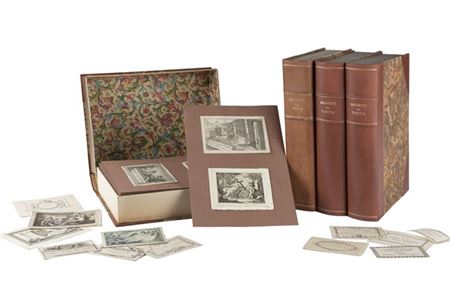 Il Ponte Casa d'Aste - Palazzo Crivelli - Via Pontaccio 12, 20121 Milano
Il Ponte Casa d'Aste - Palazzo Crivelli - Via Pontaccio 12, 20121 Milano
LIBRI E MANOSCRITTI I TORNATA : LIBRI E MANOSCRITTI
Tuesday 21 January 2020 hours 15:00 (UTC +01:00)
[BIGLIETTI DA VISITA] - Raccolta di più di 500 biglietti da visita italiani del
[BIGLIETTI DA VISITA] - Raccolta di più di 500 biglietti da visita italiani del XVIII e gli inizi del XIX secolo.
Bella raccolta che illustra la nascita e l'evoluzione del biglietto da visita a Milano, Roma e Venezia. La moda del biglietto da visita fu probabilmente importata dalla Francia e già nel 1765 Parini scrive nel "Vespro" delle "tessere beate" che circolavano negli illustri salotti meneghini. Inizialmente manoscritti, seguirono poi l'evoluzione del gusto della società; dalle semplici cornici a ghirlande iniziarono a comparire stemmi, bandiere e vedute sempre più complicate e con il fiorire del neoclassico si affermarano panorami di antichità e scene ispirate al mondo greco e romano. Attorno a questo "strumento" della bella società si sviluppò una fiorente industria e molti furono gli incisori e vedutisti che si cimentarono nel campo. Col passare del tempo il mezzo iniziò ad essere usato anche da professionisti artigiani e artisti per fini pubblicitari e dopo le fantasie di inizio secolo, verso la metà del XIX con l'affermarsi anche della litografia, il biglietto da visita assunse la forma sobria che siamo abituati a conoscere. Nella presente raccolta, oltre ai personaggi delle più importanti famiglie italiane figurano i nomi di personalità del calibro di Londonio, Paganini, Poldi Pezzoli, Hayez, il conte De Hartig e il Principe Luigi Bonaparte.
Biglietti da visita di varia tipologia applicati su cartoncino e sciolti, entro 4 raccoglitori a scatola in mezza pelle (290 x 220mm).
-EN
[BIGLIETTI DA VISITA] - Raccolta di più di 500 biglietti da visita italiani del XVIII e gli inizi del XIX secolo.
A beautiful collection illustrating the birth and evolution of the business card in Milan, Rome and Venice. The fashion of the business cards was probably imported from France and already in 1765 Parini wrote in hi "Vesproi" of the "blessed cards" circulating in the illustrious Milanese "salotti". Initially manuscripts, they then followed the evolution of the taste; from simple framesthey began to appear with crests, views of landscapes and, with the flourishing of the neoclassical style, ruines and scenes inspired by the Greek and Roman world took hold. A flourishing industry developed to realize this "instrument" of the high society and many were the engravers and painters who ventured into this field. Over time, business cards started to be used also by professionals, artisans and artists for advertising purposes. After the virtuosity of the beginning of the century, towards the mid-nineteenth century with the increasing use of lithography, the business card assumed the sober form that we know today.Included in the collection are illustrious personalities such as Londonio, Paganini, Poldi Pezzoli, Hayez, Count De Hartig and Prince Luigi Bonaparte. Business cards applied on loose cardboards (general defects) in 4 collector boxes in half calf with gilt titles to spine (290x220 mm)

